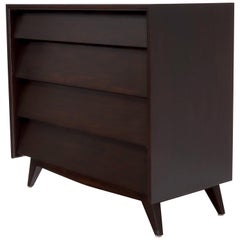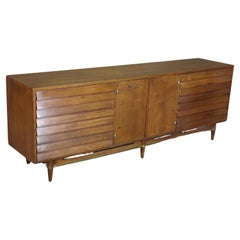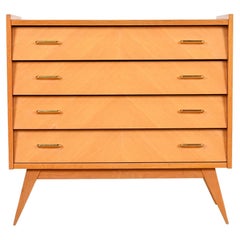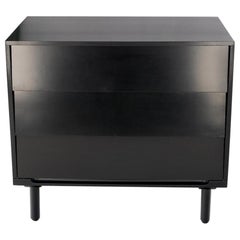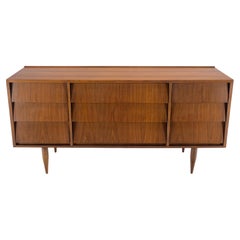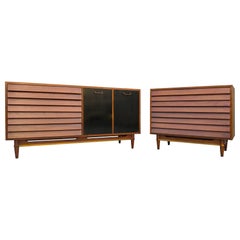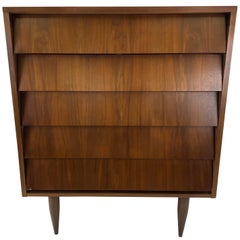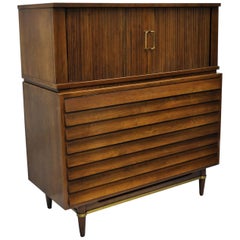Louvered Dresser Drawers
20th Century American Mid-Century Modern Commodes and Chests of Drawers
Mahogany
Mid-20th Century Mid-Century Modern Dressers
Walnut
Mid-20th Century Italian Mid-Century Modern Dressers
Brass
20th Century American Mid-Century Modern Commodes and Chests of Drawers
Birch
20th Century American Mid-Century Modern Credenzas
Walnut
Vintage 1960s American Mid-Century Modern Cabinets
Brass, Enamel
Recent Sales
Vintage 1960s American Mid-Century Modern Dressers
Walnut
Mid-20th Century American Mid-Century Modern Dressers
Walnut
Vintage 1960s American Mid-Century Modern Dressers
Vintage 1960s American Mid-Century Modern Dressers
Vintage 1970s American Mid-Century Modern Dressers
Brass
20th Century American Mid-Century Modern Commodes and Chests of Drawers
Vintage 1960s North American Mid-Century Modern Dressers
Walnut
Vintage 1960s Mid-Century Modern Secretaires
Walnut
Vintage 1960s American Mid-Century Modern Dressers
People Also Browsed
2010s South African Minimalist Pedestals
Hardwood
21st Century and Contemporary Swedish Mid-Century Modern Table Lamps
Textile
2010s Italian Mid-Century Modern Wall Lights and Sconces
Brass
Mid-20th Century American Mid-Century Modern Credenzas
Brass
21st Century and Contemporary American Mid-Century Modern Wall Lights an...
Brass
2010s Table Lamps
Iron
21st Century and Contemporary French Brutalist Night Stands
Oak
Mid-20th Century American Mid-Century Modern Dressers
Steel
Mid-20th Century Italian Mid-Century Modern Night Stands
Brass
Vintage 1960s American Mid-Century Modern Credenzas
Brass
Vintage 1970s American Mid-Century Modern Credenzas
Brass
Vintage 1960s French Mid-Century Modern Commodes and Chests of Drawers
Oak
Mid-20th Century Mid-Century Modern Dressers
Teak
Mid-20th Century American Mid-Century Modern End Tables
Laminate, Walnut
Mid-20th Century American Mid-Century Modern Credenzas
Brass
Vintage 1970s Mid-Century Modern Credenzas
Walnut
Louvered Dresser Drawers For Sale on 1stDibs
How Much are Louvered Dresser Drawers?
A Close Look at Mid-century-modern Furniture
Organically shaped, clean-lined and elegantly simple are three terms that well describe vintage mid-century modern furniture. The style, which emerged primarily in the years following World War II, is characterized by pieces that were conceived and made in an energetic, optimistic spirit by creators who believed that good design was an essential part of good living.
ORIGINS OF MID-CENTURY MODERN FURNITURE DESIGN
- Emerged during the mid-20th century
- Informed by European modernism, Bauhaus, International style, Scandinavian modernism and Frank Lloyd Wright’s architecture
- A heyday of innovation in postwar America
- Experimentation with new ideas, new materials and new forms flourished in Scandinavia, Italy, the former Czechoslovakia and elsewhere in Europe
CHARACTERISTICS OF MID-CENTURY MODERN FURNITURE DESIGN
- Simplicity, organic forms, clean lines
- A blend of neutral and bold Pop art colors
- Use of natural and man-made materials — alluring woods such as teak, rosewood and oak; steel, fiberglass and molded plywood
- Light-filled spaces with colorful upholstery
- Glass walls and an emphasis on the outdoors
- Promotion of functionality
MID-CENTURY MODERN FURNITURE DESIGNERS TO KNOW
- Charles and Ray Eames
- Eero Saarinen
- Milo Baughman
- Florence Knoll
- Harry Bertoia
- Isamu Noguchi
- George Nelson
- Danish modernists Hans Wegner and Arne Jacobsen, whose emphasis on natural materials and craftsmanship influenced American designers and vice versa
ICONIC MID-CENTURY MODERN FURNITURE DESIGNS
- Eames lounge chair
- Nelson daybed
- Florence Knoll sofa
- Egg chair
- Womb chair
- Noguchi coffee table
- Barcelona chair
VINTAGE MID-CENTURY MODERN FURNITURE ON 1STDIBS
The mid-century modern era saw leagues of postwar American architects and designers animated by new ideas and new technology. The lean, functionalist International-style architecture of Le Corbusier and Bauhaus eminences Ludwig Mies van der Rohe and Walter Gropius had been promoted in the United States during the 1930s by Philip Johnson and others. New building techniques, such as “post-and-beam” construction, allowed the International-style schemes to be realized on a small scale in open-plan houses with long walls of glass.
Materials developed for wartime use became available for domestic goods and were incorporated into mid-century modern furniture designs. Charles and Ray Eames and Eero Saarinen, who had experimented extensively with molded plywood, eagerly embraced fiberglass for pieces such as the La Chaise and the Womb chair, respectively.
Architect, writer and designer George Nelson created with his team shades for the Bubble lamp using a new translucent polymer skin and, as design director at Herman Miller, recruited the Eameses, Alexander Girard and others for projects at the legendary Michigan furniture manufacturer.
Harry Bertoia and Isamu Noguchi devised chairs and tables built of wire mesh and wire struts. Materials were repurposed too: The Danish-born designer Jens Risom created a line of chairs using surplus parachute straps for webbed seats and backrests.
The Risom lounge chair was among the first pieces of furniture commissioned and produced by celebrated manufacturer Knoll, a chief influencer in the rise of modern design in the United States, thanks to the work of Florence Knoll, the pioneering architect and designer who made the firm a leader in its field. The seating that Knoll created for office spaces — as well as pieces designed by Florence initially for commercial clients — soon became desirable for the home.
As the demand for casual, uncluttered furnishings grew, more mid-century furniture designers caught the spirit.
Classically oriented creators such as Edward Wormley, house designer for Dunbar Inc., offered such pieces as the sinuous Listen to Me chaise; the British expatriate T.H. Robsjohn-Gibbings switched gears, creating items such as the tiered, biomorphic Mesa table. There were Young Turks such as Paul McCobb, who designed holistic groups of sleek, blond wood furniture, and Milo Baughman, who espoused a West Coast aesthetic in minimalist teak dining tables and lushly upholstered chairs and sofas with angular steel frames.
Generations turn over, and mid-century modern remains arguably the most popular style going. As the collection of vintage mid-century modern chairs, dressers, coffee tables and other furniture for the living room, dining room, bedroom and elsewhere on 1stDibs demonstrates, this period saw one of the most delightful and dramatic flowerings of creativity in design history.
Finding the Right Dressers for You
Antique, new and vintage dressers are a staple in any household. Whether it’s a 19th-century solid pine or oak Welsh kitchen dresser you’re using to store tableware or a Broyhill Brasilia highboy in your bedroom, these furniture fixtures are essential for making the most of your space.
The first step in finding the perfect dresser is considering your particular needs. Most tall dressers offer anywhere from five to seven drawers, essentially allowing for the organization of an entire wardrobe, while shorter, waist-height dresser varieties can be equipped with a convenient vanity mirror.
A highboy dresser is usually around six feet tall, with some versions standing even taller at seven feet or so. Highboys, which began to appear with frequency during the early 17th century in England, are essentially very tall dressers with lots of drawers, whereas a lowboy is a different type of storage furniture in that it's a dressing table with one or two rows of drawers.
When shopping for your antique or vintage dresser, consider those that bear the hallmarks of solid construction. Good furniture means making an investment, and solid hardwood pieces of maple, walnut or cherry will prove far more durable than a bedroom dresser made of particleboard.
If you’re looking for a mid-century modern case piece that boasts a subdued pairing of wood grains and uncomplicated drawer pulls, browse elegant dressers designed by Florence Knoll, Harvey Probber, Paul McCobb and other furniture makers associated with the celebrated style on 1stDibs.
Dressers characterized by bolder designs are also popular: Not only will your new piece of furniture be a storage solution, but it'll also make a statement.
Art Deco furniture makers preferred to work with dark woods and typically incorporated decorative embellishments. An ornately carved French or Italian Art Deco dresser complete with vanity mirror and cabriole scrolled feet might better complement the other pieces in your home. Alternatively, if you favor sumptuous antique furniture with curving lines and floral flourishes, the collection on 1stDibs also includes sophisticated 1800s-era Victorian walnut dressers and washstands with marble tops.
After all, a good case piece isn’t merely for minimizing clutter in your space. The style of your chosen dresser and its specific attributes should add something to your decor and your home. Modern creations include one-of-a-kind shapes, like the venturesome chests of drawers in leather, marble and wood crafted by the likes of Roberto Cavalli.
Explore a broad array of antique and vintage dressers today on 1stDibs.
- 1stDibs ExpertOctober 7, 2024The difference between a dresser and a drawer is that one is a piece of furniture, and the other is a storage feature found in many types of furniture. A drawer is a storage compartment that slides out of a surrounding frame, giving you access to whatever you place inside. Dresser is the term for a long, low piece of bedroom furniture that usually features two or more columns of drawers. Drawers are also found in built-in cabinetry, bathroom vanities, desks and other types of casegood furniture. On 1stDibs, shop a large collection of dressers.
- 1stDibs ExpertApril 5, 2022To remove Thomasville dresser drawers, first empty them. Then, pull one drawer out to its farthest point. Feel around the interior of the dresser on both sides. Locate the release button. While pushing on the button, lift the drawer up and out. Find a range of Thomasville dressers on 1stDibs.
- 1stDibs ExpertNovember 13, 2024What a tall dresser with drawers is called depends on its design. A one-piece tall dresser may be referred to as a vertical dresser or a vertical chest of drawers. On the other hand, a tall dresser that consists of two sections stacked one atop the other is a highboy or a tallboy. Shop a large selection of dressers from some of the world's top sellers on 1stDibs.
- 1stDibs ExpertApril 1, 2024How deep the average dresser drawer is depends on the size of the dresser. The depth of dresser drawers ranges from approximately 14 or 15 inches to around 20 inches. The depth of drawers in larger dressers may exceed 20 inches. A dresser’s drawers will typically be deeper than those in a chest of drawers.
So, what makes a chest of drawers different from a common dresser? Dressers are short, and chests of drawers are overall taller pieces of furniture that typically do not have room on the top for a mirror as most dressers do.
Antique and vintage dressers are a staple in any household. Whether it’s a 19th-century solid pine or oak Welsh kitchen dresser you’re using to store tableware or a Broyhill Brasilia highboy in your bedroom, these furniture fixtures are essential for making the most of your space.
Find antique dressers as well as vintage mid-century modern dressers on 1stDibs. - 1stDibs ExpertApril 5, 2022To remove Broyhill dresser drawers, first take everything out of them. Then, pull one drawer out as far as it will go. Locate the latch along the inside of the dresser on the right side. Push the latch toward the track to trigger the release mechanism. Then, slide the drawer out the rest of the way. Find a range of Broyhill dressers on 1stDibs.
- 1stDibs ExpertNovember 2, 2021Dressers are designed to offer a place for you to dress, with the top functioning as a table on which to place your clothing. It will offer space for a mirror, whereas chests of drawers are typically exactly that — they provide ample storage while taking up little floor space. A dresser is usually wide and short, while a chest of drawers is narrow and tall. Both types of furniture are commonly used to store clothing and other items in drawers. Shop a collection of antique, vintage, and contemporary dressers and chests of drawers from some of the world’s top dealers on 1stDibs.
- 1stDibs ExpertApril 1, 2024Yes, there is a difference between a dresser and a chest of drawers. Dressers are short, and chests of drawers are overall taller pieces of furniture that typically do not have room on the top for a mirror as most dressers do.
Although the name immediately invokes images of clothing, dressers were initially created in Europe for a much different purpose. This type of case piece was originally a flat-surfaced, low-profile side table equipped with a few drawers — a common fixture used to dress and prepare meats in English kitchens throughout the Tudor period.
Find antique and vintage dressers for sale on 1stDibs. - 1stDibs ExpertApril 26, 2024What a good depth for dresser drawers is depends on what you wish to store. The average depth is 16 to 18 inches, and drawers of this size can accommodate a wide range of items. Some dressers have a mix of deep and shallow drawers, giving you the flexibility to store and organize many kinds of clothing, undergarments and accessories. On 1stDibs, shop a wide variety of dressers.
- 1stDibs ExpertAugust 26, 2024The difference between a bureau, a chest of drawers and a dresser comes down to shape and function. Dressers and chests of drawers are both types of bedroom furniture that feature storage drawers. However, bureaus tend to be wider and shorter, while chests of drawers are narrower and taller. Often used for storage outside of bedrooms, bureaus are usually about the same height as dressers but are shorter than chests of drawers. Find a wide range of casegoods on 1stDibs.
- 1stDibs ExpertOctober 7, 2024The difference between a dresser, a bureau and a chest of drawers is where you place these furnishings and their overall shapes and designs. Usually positioned in a bedroom, a dresser is a wide, low casegood consisting of two or more columns of drawers. When this type of furniture is placed in a living room, office, library or other space beyond the bedroom, people normally refer to it as a bureau. Another type of bedroom furnishing is a chest of drawers, which is a tall vertical column of drawers stacked one above the other. On 1stDibs, shop a diverse assortment of dressers, bureaus and chests of drawers.
